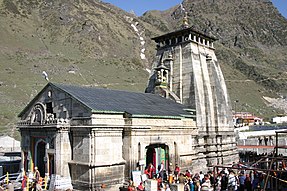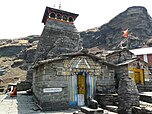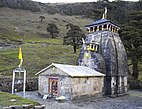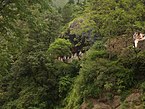Kedarnath Temple
| Kedarnath Temple | |
|---|---|
Pandavas | |
| Elevation | 3,583 m (11,755 ft) |
| Website | |
| badrinath-kedarnath | |
| Part of a series on |
| Shaivism |
|---|
 |
|
|
Kedarnath Temple (
The temple is not directly accessible by road and has to be reached by a 22 kilometres (14 mi) uphill trek from
Kedarnath was the worst affected area during the 2013 flash floods in North India. The temple complex, surrounding areas, and Kedarnath town suffered extensive damage, but the temple structure did not suffer any major damage, apart from a few cracks on one side of the four walls which was caused by the flowing debris from the higher mountains. A large rock among the debris acted as a barrier, protecting the temple from the flood. The surrounding premises and other buildings in the market area were heavily damaged.[6]
History and legends of origin
At a height of 3,583 m (11,755 ft), 223 km (139 mi) from
A folk legend about Kedarnath relates to the Pandavas, the heroes of the Hindu epic
A variant of the tale credits Bhima for not only catching the bull but also stopping it from disappearing. Consequently, the bull was torn asunder into five parts and appeared at five locations in the
After completing the pilgrimage of Lord Shiva's
The
According to the
Kedarnath Teerth Purohits are the ancient Brahmins of this region, their ancestors (Rishi-Muni) have been worshiping the lingam since the time of Nara-Narayana and Daksh Prajapati. King Janmejay, grandson of the Pandavas, gave them the right of worshiping this temple and donate the whole Kedar region, and they have been worshiping pilgrims ever since.[8][13][14]
According to a tradition recorded by the English mountaineer
Deities and architecture
The presiding image of Kedarnath in the form of
Rituals
The head priest (Raval) of the Kedarnath temple belongs to the
Administration
The temple was included in the Uttar Pradesh State Government Act No. 30/1948 as Act no. 16,1939, which came to be known as Shri Badarinath and Shri Kedarnath Mandir Act. The committee nominated by the state government administers both temples. The act was modified in 2002 by the Uttarakhand State Government, which provisioned adding additional committee members including government officials and a vice-chairman.
2013 floods

The Kedarnath valley, along with other parts of the state of Uttarakhand, was hit with unprecedented flash floods on 16 and 17 June 2013. On 16 June, at about 7:30 p.m. a landslide and mudslides occurred near Kedarnath Temple with loud peals of thunder. An enormously loud peal was heard and huge amounts of water started gushing from Chorabari Tal or Gandhi Tal down Mandakini river at about 8:30 p.m. washing everything away in its path. On 17 June 2013 at about 6:40 a.m. waters again started cascading at a huge speed from river Swaraswati and Chorabari Tal or Gandhi Tal bringing along with its flow huge amount of silt, rocks, and boulders. A huge rock got stuck behind Kedarnath Temple and protected it from the ravages of the flood. The waters gushed on both the sides of the temple destroying everything in their path. Even eyewitness observed that one large rock got carried to the rear side of Kedarnath Temple, thus causing obstruction to the debris, diverting the flow of river and debris to the sides of the temple avoiding damage. The rock which protected the temple is worshipped as the God's Rock (भीम शीला).
Another theory for the temple not being destroyed is because of its construction. The experts, who were asked by the Archaeological Survey of India to examine the condition of the foundation in wake of the floods have arrived at the conclusion that there was no danger to the temple. The IIT Madras experts visited the temple thrice for the purpose. Non-destructive testing instruments that do not disturb the structure of the temple were used by the IIT-team for assessing the health of the structure, foundation, and walls. They have submitted their interim report that the temple is stable and there was no major danger.[31][32]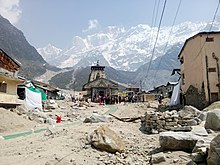
Nehru Institute of Mountaineering (NIM) was given the responsibility of rebuilding Kedarnath. Although the institute did not have the expertise in urban planning or construction, they mastered in high altitude training. Under the leadership of veteran mountaineer, Colonel Ajay Kothiyal, NIM rigorously worked for a year and made the pilgrimage yatra possible from the next year.[33]
See also
- Adi Shankara
- Gangotri Temple
- Gaurikund
- Jyotirlinga
- Yamunotri Temple
- Chota Char Dham
- Panch Kedar
- Jageshwar
References
- ^ ISBN 978-0-8239-3179-8.
- ^ a b "Kedarnath Temple". Kedarnath - The official website. 2006. Retrieved 16 May 2021.
- ISBN 978-1-59884-204-3.
- ^ "KEDARNATH". chardhamtour.
- ^ "Tiruketharam (Kedarnath)" (in Tamil). Archived from the original on 6 November 2021. Retrieved 6 November 2021.
- ^ Joanna Sugden; Shreya Shah (19 June 2013). "Kedarnath Temple Survives Flash Floods". WSJ.
- ^ Abram, David (2003). The Rough guide to India. New York: Rough Guides.
- ^ ISBN 978-0-307-83295-5.
- ^ a b "Panch Kedar Yatra". Retrieved 5 July 2009.
- ISBN 9788185880167.
- ^ "Panch Kedar". chardhamtour.in. 5 March 2014. Retrieved 4 March 2022.
- ^ "Panch Kedar". Archived from the original on 31 August 2009. Retrieved 15 July 2009.
- ^ ISBN 978-90-04-30618-9.
- ^ ISBN 978-0-7914-1282-4.
- ISBN 978-1-4381-0873-5.
- ISBN 978-0-415-33422-8.
- ^ a b "Kedarnath Temple: Interesting Facts About The Significant Lord Shiva Temple That Will Leave You Surprised". English Jagran. 20 December 2023. Retrieved 31 January 2024.
- ISBN 978-81-7907-053-6.
- ^ Whitmore, Luke (2018). Mountain, Water, Rock, God: Understanding Kedarnath in the twenty-first century. University of California Press. p. 38.
- ^ "Uttarakhand government website". Government of Uttarakhand. Archived from the original on 10 June 2008. Retrieved 9 September 2013.
- ^ a b c "Kedarnath priest's family prays for his safe return". Deccan Herald. 24 June 2013. Retrieved 9 September 2013.
- ^ "Garhwali Dance Forms". euttaranchal.com. 6 March 2013.
- ^ "Administration of the temple". Shri Badrinath - Shri Kedarnath Temples Committee. 2006.
- ^ "Committee members of the temple". Shri Badrinath - Shri Kedarnath Temples Committee. 2006.
- ^ "Religious setup of the temple". Shri Badrinath - Shri Kedarnath Temples Committee. 2006.
- ^ "Power structure of the temple". Shri Badrinath - Shri Kedarnath Temples Committee. 2006. Retrieved 9 September 2013.
- ^ "What happened on the night of 16th June inside Kedarnath temple". Tehelka.com. 17 June 2013. Archived from the original on 29 October 2013. Retrieved 9 September 2013.
- ^ "Account of survivors of Uttarakhand floods". Yahoo newsuutar. 17 June 2013. Retrieved 9 September 2013.
- ^ "Account of survivors". youtube.com. 17 June 2013. Archived from the original on 31 October 2021. Retrieved 9 September 2013.
- ^ "Account of flood victims". youtube.com. 17 June 2013. Archived from the original on 31 October 2021. Retrieved 9 September 2013.
- ^ "Monsoon fury leaves Kedarnath shrine submerged in mud and slush". The Indian Express. 19 June 2013. Retrieved 9 September 2013.
- ^ "Kedarnath shrine safe, to remain closed for a year". The Hindu. 19 June 2013. Retrieved 9 September 2013.
- ^ "In Rebuilding Kedarnath, a New Disaster in the Making". The Wire. Retrieved 1 June 2019.
Further reading
- Chaturvedi, B. K. (2006). Shiv Purana (First ed.). New Delhi: Diamond Pocket Books (P) Ltd. ISBN 81-7182-721-7.
- Eck, Diana L. (1999). Banaras, city of light (First ed.). New York: Columbia University Press. ISBN 0-231-11447-8.
- Gwynne, Paul (2009). World Religions in Practice: A Comparative Introduction. Oxford: Blackwell Publication. ISBN 978-1-4051-6702-4.
- Harding, Elizabeth U. (1998). "God, the Father". Kali: The Black Goddess of Dakshineswar. Motilal Banarsidass. pp. 156–157. ISBN 978-81-208-1450-9.
- Lochtefeld, James G. (2002). The Illustrated Encyclopedia of Hinduism: A-M. Rosen Publishing Group. p. 122. ISBN 0-8239-3179-X.
- R., Venugopalam (2003). Meditation: Any Time Any Where (First ed.). Delhi: B. Jain Publishers (P) Ltd. ISBN 81-8056-373-1.
- Vivekananda, Swami. "The Paris Congress of the History of Religions". The Complete Works of Swami Vivekananda. Vol. 4.



